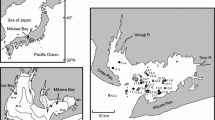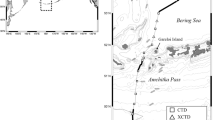Abstract
The Yellow Sea, characterized by a high concentration of suspended solids, is a semi-enclosed, marginal sea and shallow water in the northwestern Pacific Ocean, located between the Korean Peninsula and China. In this paper, we describe the response of acoustically determined weighted mean depth (WMD) of the krill, Euphausia pacifica, to variations in suspended solid concentration (SSC) during the daytime in spring and summer. E. pacifica was identified from the difference in the volume backscattering strength at 38 and 200 kHz. Our results indicated a correlation between the WMD of E. pacifica and the density of SSC during the daytime in both spring and summer. E. pacifica aggregation was distributed mainly near the bottom when the SSC was relatively low, but did not descend to the bottom when the SSC was relatively high. This implies that the SSC may be an important environmental factor affecting the behavior of E. pacifica.







Similar content being viewed by others
References
Nakao T (1977) Oceanic variability in relation to fisheries in the East China Sea and the Yellow Sea. J Fac Mar Sci Technol Tokai Univ (Special Number) 199–367 (in Japanese)
Teague WJ, Jacobs GA (2000) Current observations on the development of the Yellow Sea warm current. J Geophys Res 105:3401–3411
Kang J, Kim W (2008) Spring dominant copepods and their distribution pattern in the Yellow Sea. Ocean Sci J 43:67–79
Sun S, Huo Y, Yang B (2010) Zooplankton functional groups on the continental shelf of the Yellow Sea. Deep-Sea Res II 57:1006–1016
Zaret TM, Suffern JS (1976) Vertical migration in zooplankton as a predator avoidance mechanism. Limnol Oceanogr 21:804–813
Forward RB (1988) Diel vertical migration: zooplankton photobiology and behaviour. Oceanogr Mar Biol Annu Rev 26:1–393
Lampert W (1989) The adaptive significance of diel vertical migration of zooplankton. Funct Ecol 3:21–27
Murphy HM, Jenkins GP, Hamer PA, Swearer SE (2011) Diel vertical migration related to foraging success in snapper Chrysophrys auratus larvae. Mar Eco Prog Ser 433:185–194
Lee H, Cho S, Kim W, Kang D (2013) The diel vertical migration of the sound-scattering layer in the Yellow Sea bottom cold water of the southeastern Yellow Sea: focus on its relationship with a temperature structure. Acta Oceanol Sin 32:44–49
Pieper RE, Holliday DV, Kleppel GS (1990) Quantitative zooplankton distributions from multifrequency acoustics. J Plankton Res 12:433–441
Kim E, Lee H, Na J, Choi JW, Kang D (2010) 5-MHz acoustic-backscatter measurements of Cochlodinium polykrikoides blooms in Korean coastal waters. ICES J Mar Sci 67:1759–1765
Chen C, Beardsley RC, Limeburner R, Kim K (1994) Comparison of winter and summer hydrographic observations in the Yellow and East China Seas and adjacent Kuroshio during 1986. Cont Shelf Res 14:909–929
Lim DI, Choi JY, Jung HS, Pho KC, Ahn KS (2007) Recent sediment accumulation and origin of shelf mud deposits in the Yellow and East China Seas. Prog Oceanogr 73:145–159
Wells JT (1988) Distribution of suspended sediment in the Korea Strait and southeastern Yellow Sea: onset of winter monsoons. Mar Geol 83:273–284
Onsrud MS, Kaartvedt S (1998) Diel vertical migration of the krill Meganyctiphanes norvegica in relation to physical environment, food and predators. Mar Ecol Prog Ser 171:209–219
Utne ACW (1997) The effect of turbidity and illumination on the reaction distance and search time of the marine planktivore Gobiusculus flavescens. J Fish Biol 50:926–938
Granqvist M, Mattila J (2004) The effects of turbidity and light intensity on the consumption of mysids by juvenile perch (Perca fluviatilis L.). Develop Hydrobiol 514:93–101
Simmonds EJ, MacLennan D (2005) Fisheries acoustics: theory and practice. Wiley-Blackwell, Oxford
Myriax (2008) EchoView Myriax Software Pty Ltd, Hobart, Tasmania, Australia
Madureira LSP, Ward P, Atkinson A (1993) Differences in backscattering strength determined at 120 and 38 kHz for three species of Antarctic macroplankton. Mar Ecol Prog Ser 93:17–24
Conti SG, Demer DA (2006) Improved parameterization of the SDWBA for estimating krill target strength. ICES J Mar Sci 63:928–935
Mikami H, Mukai T, Iida K (2000) Measurement of density and sound speed contrasts for estimating krill target strength using theoretical scattering models. Nippon Suisan Gakkaishi 66:682–689 (in Japanese with English abstract)
Mukai T, Iida K, Ando Y, Mikami H, Maki Y, Matsukura R (2000) Measurements of swimming angles, density, and sound speed of the krill Euphausia pacifica for target strength estimation. In: Proceedings of Oceans ’04, Kobe, Japan, 9–12 November, 2004, pp 383–388
Matsukura R, Mukai T, Ando Y, Iida K (2009) The variation of density and sound speed contrasts and theoretical target strength estimation of Euphausia pacifica. Nippon Suisan Gakkaishi 75:38–44 (in Japanese with English abstract)
Miyashita K, Aoki I, Inagaki T (1996) Swimming behaviour and target strength of isada krill (Euphausia pacifica). ICES J Mar Sci 53:303–308
Jarvis T, Kelly N, Kawaguchi S, Wijk EV, Nicol S (2010) Acoustic characterisation of the broad-scale distribution and abundance of Antarctic krill (Euphausia superba) off East Antarctica (30–80° E) in January–March 2006. Deep-Sea Res II 57:916–933
Frost BW, Bollens SM (1992) Variability of diel vertical migration in the marine planktonic copepod Pseudocalanus newmani in relation to its predators. Can J Fish Aquat Sci 49:1137–1141
Sainmont J, Thygesen UH, Visser AW (2013) Diel vertical migration arising in a habitat selection game. Theor Ecol 6:241–251
Frank TM, Widder EA (2002) Effects of a decrease in downwelling irradiance on the daytime vertical distribution patterns of zooplankton and micronekton. Mar Biol 140:1181–1193
Eiane K, Aksnes DL, Bagøien E, Kaartvedt S (1999) Fish or jellies: a question of visibility? Limnol Oceanogr 44:1352–1357
Yoon WD, Cho SH, Lim D, Choi YK, Lee Y (2000) Spatial distribution of Euphausia pacifica (Euphausiacea: Crustacea) in the Yellow Sea. J Plankton Res 22:939–949
Medwin H, Clay CS (1997) Fundamentals of acoustical oceanography. Academic Press, London
Urick RJ (1983) Principles of underwater sound. McGraw-Hill, London
Gartner JW, Cheng RT, Wang PF, Richter K (2001) Laboratory and field evaluations of the LISST-100 instrument for suspended particle size determinations. Mar Geol 175:1–4
In HJ, Park SU (2003) The soil particle size dependent emission parameterization for an Asian dust (yellow sand) observed in Korea in April 2002. Atmos Environ 37:4625–4636
Stanton TK, Chu D (2000) Review and recommendations for the modelling of acoustic scattering by fluid-like elongated zooplankton: euphausiids and copepods. ICES J Mar Sci 57:793–807
Acknowledgments
This study was supported by “The study on the impact of the Yellow Sea cold water mass to the ecosystemˮ grant (PE99233), promoted by the Korea Institute of Ocean Science and Technology. The authors thank Mr. Heejung Choi and Ms. Mira Kim for their support in the system calibration, and special thanks to the crew of the RV Eardo for their help in the field data acquisition.
Author information
Authors and Affiliations
Corresponding author
Rights and permissions
About this article
Cite this article
Lee, H., Kang, D. & Choi, J.W. The effect of the suspended solid concentration on the daytime vertical distribution of Euphausia pacifica in the Yellow Sea, Korea. Fish Sci 81, 849–859 (2015). https://doi.org/10.1007/s12562-015-0904-5
Received:
Accepted:
Published:
Issue Date:
DOI: https://doi.org/10.1007/s12562-015-0904-5




